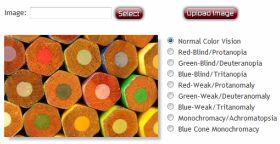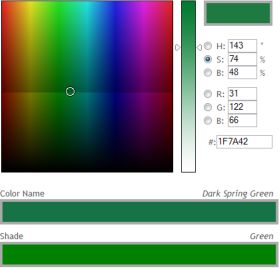The following list of on- and offline tools for colorblind persons was put together by JNvB, the founder and owner of www.kleurenblindheid.nl.
This is an overview of available software and websites which either help and assist you if you are suffering from color blindness (Visolve, Daltap, eyePilot™) or tools that can show you how the world looks like for colorblind persons. Next to that, programs are indicated that can recognize color and can show the name and/or code (e.g. RGB).
Assistive Software for Colorblind People
Visolve by Ryobi System Solutions

Using a filter, Visolve allows better discrimination of colors by making colors lighter and/or darker, or increasing the saturation.
Unique is the ability to give each color a different hatch pattern, which is very useful for charts or diagrams.
The filters of Visolve:
- Red/Green filter: red colors lighter, green colors darker
- Blue/Yellow filter: blue colors lighter, yellow colors darker
- Saturation filter: increases the intensity of all colors
- Filtering: colors other than the specified color are darkened
- Hatching: each color is hatched differently
Platforms:
- Windows NT, 2000 or XP (probably works on 98 and Me)
- Mac OS v10.4 or higher (probably also v10.2 and up)
Download: Visolve
Free for personal and non-commercial use.
Daltap by Glenn Heylen

Daltap has several features combined of which the flashing feature is the most useful. By flashing, it shows where a picked color is on your screen. Next to that, it can give the name of the color at the tip of mouse and it can also zoom in the area that is near the mouse.
The features of Daltap:
- Naming feature: show the name of the color (basic and detailed)
- Flashing feature: chosen color flashes on the screen
- Mini zoom feature: enlarges the area around the mouse
Platform:
- Windows XP, Vista with Windows .NET Framework 2.0
Download: Daltap
Free to use.
eyePilot™ by Tenebraex

Several filters that allows better identification of colors by graying out all colors except the one chosen or by flashing a picked color. It can also make a color turn black by clicking on the name and it can show the name of color. On top of that, it can change the hue of colors, increasing the contrast between colors.
The filters of eyePilot™:
- Gray filter: all colors gray but the picked color
- Flashing filter: a chosen color flashes
- Name filter: shows the name of the color the mouse points at
- Hue filter: adjusts the saturation of colors
Platforms:
- Windows NT, 2000 and XP
- Mac OS v10.2 and higher
Download: eyePilot™
Fully functional trail version for 30 days. Thereafter an activation code is needed for which you have to pay $34.00.
ColorBlindExt by Onkar Rukar, Gaurav Savkar, and Tushar Pagar

This Firefox add-on offers the possibility to change websites, text and figures such that it is better readable for the colorblind. This can be done while browsing or via a menu with the following filters:
- Red filter (for protanopia and protanomaly)
- Green filter (for deuteranopia and deuteranomaly)
- Blue filter (for tritanopia and tritanomaly)
- Monochromacy
Platform:
- FireFox 2.0 or higher with Java Runtime Environment 1.5 or Java Advanced Imaging Run Time 1.1.3 or higher.
Link: ColorBlindExt
Color Blindness Simulation
Color Oracle by Bernhard Jenny and Nathaniel Vaughn Kelso

Places a filter over the screen to simulate colorblindness directly showing how it looks like for a colorblind person.
Color Oracle can simulate the three main types of color blindness:
- Deuteranopia (green-blindness: most common form of color vision deficiency)
- Protanopia (red-blindness: rare form)
- Tritanopia (blue-blindness: very rare form)
Platforms:
- Windows 2000, XP or Vista with Java 6
- Mac OS v10.4 or higher
- Linux with Java 6
Download: Color Oracle
Free to use.
ColorDoctor by Fujitsu

ColorDoctor not only simulates website display, it is also possible to simulate real-time display of for example moving images such as Flash by selecting the “Transparent” mode. It is possible to show the display content through four different conversion filters:
- Grayscale
- Protanopia
- Deuteranopia
- Tritanopia
The simulation result can be stored in various file formats, including BMP, JPEG, PNG, TIFF, and GIF.
Platform:
- Windows XP and Vista with Windows .NET Framework 1.1 or higher
Download: ColorDoctor
Free to use.
Sim Daltonism by Michel Fortin

Sim Daltonism filters in real-time the area around the mouse pointer and displays the result—as seen by a color blind person—in a floating palette.
Sim Daltonism can simulate eight types of colorblindness:
- Monochromacy (complete)
- Monochromacy (partial)
- Protanomaly (red-weakness)
- Protanopia (red-blindness)
- Deuteranomaly (green-weakness)
- Deuteranopia (green-blindness)
- Tritanomaly (blue-weakness)
- Tritanopia (blue-blindness)
Platform:
- Mac OS X 10.2.8 or higher
Download: Sim Daltonism
Free to use.
Online Color Blindness Simulation
Coblis by Colblindor
Coblis was designed to help non colorblind people to understand how an image looks like if you have a certain type of color vision deficiency.
You can either try the different types of color blindness on the given sample picture or upload your own images and see how they look if you would be colorblind.
The following types of color blindness are supported by Coblis:
- Normal Color Vision
- Red-Blind/Protanopia
- Green-Blind/Deuteranopia
- Blue-Blind/Tritanopia
- Red-Weak/Protanomaly
- Green-Weak/Deuteranomaly
- Blue-Weak/Tritanomaly
- Monochromacy/Achromatopsia
- Blue Cone Monochromacy
Link: Coblis
Vischeck by Bob Dougherty and Alex Wade

The online service of Vischeck offers two types of simulation:
- Vischeck: shows how pictures look for colorblind people
- Daltonize: corrects images if you are colorblind
Vischeck itself can simulate the three main types of color blindness either using an image or by running it directly on a webpage:
- Protanopia
- Deuteranopia
- Tritanopia
Daltonize makes it possible to adjust the ratio of red/green & blue/yellow and brightness of colors of images making them more readable for a colorblind person.
Next to the website, Vischeck offers a plug-in to do the simulations offline with the help of Adobe Photoshop or ImageJ (see Vischeck downloads):
- VischeckPS – Windows
- VischeckPS – Mac
- VischeckJ 1.0
Link: Vischeck
Colorblind Web Page Filter by Matthew Wickline

The purpose of colorblind webpage filter is, as the name already suggests, to show how webpages are seen by colorblind people.
To do this, you can choose between all different kinds of color vision deficiency:
- Monochromacy
- Blue Cone Monochromacy
- Protanomaly (red-weakness)
- Protanopia (red-blindness)
- Deuteranomaly (green-weakness)
- Deuteranopia (green-blindness)
- Tritanomaly (blue-weakness)
- Tritanopia (blue-blindness)
Additionaly it is possible to toggle stylesheet inclusion, image filtering and the special case of non-gif image filtering.
Link: Colorblind Web Page Filter
Color Vision by Cal Henderson

When designing a website, brochures, etc, Color Vision comes in very handy.
On the website you pick text and background color and check how this looks like in the case of:
| Trichromat: | Normal | ||
| Anomalous Trichromat: | Protanomaly | Deuteranomaly | Tritanomaly |
| Dichromat: | Protanopia | Deutanopia | Tritanopia |
| Monochromat: | Typical | Atypical |
Link: Color Vision
Color Recognition
Eyedropper by Inetia.com
Enlarges the area around the tip of the mouse and tells which color it points to in several different color systems like HEX, RGB, and CMYK.
Next to that, it is possible to make some image capturing or use the value switchable mode, which allows you to choose between normal, grayscale and websafe colors.
Platform:
- Windows 95, 98, NT, 2000, XP, and Vista
Download: Eyedropper
Free to use.
WhatColor by Hikaru Nakahara

Enlarges the area around the tip of the mouse one to four times and tells which color it points to in several different color systems like RGB, decimal, HSV and HLS.
Additionally it gives the name of the color the mouse points to, which is very handy for colorblind users. And on top of that it can even pronounce the color names.
Platform:
- Windows 95, 98, Me, NT, 2000, XP, and Vista
Download: WhatColor
Fully functional trail version. Thereafter an activation code is needed for which you have to pay $8.00.
Online Color Recognition
Color Name & Hue by Colblindor
By giving in a color as a RGB, HSB, or hexadecimale colorsystem value, Color Name & Hue associates a color name and the corresponding hue out of more than 1600 colors.
Color names can also be found by placing the circle on one of the main colors followed by moving around the slider to find the hue of the color of interest.
Link: Color Name & Hue
Name that Color by Chirag Mehta

You can either select a color by its name, enter a hexadecimal color value or select a color on a color selector wheel. Name that color will find the closest match out of a list of more than 1500 colors and name it.
Link: Name that Color
Thanks very much to JNvB from www.kleurenblindheid.nl for this comprehensive list of tools for colorblind and not colorblind people. If you know of any more please add them in the comments section.



